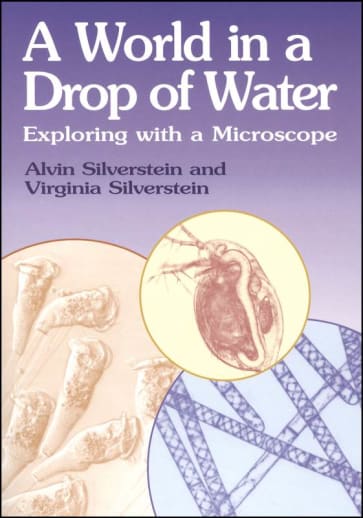Why wait until high school biology to start discovering the microscopic world? With this inexpensive book, a microscope and a drop of pond water, any youngster can find out about the world's smallest animals. Watch the blob-like amoeba hunt and devour its prey. See the slipper-shaped paramecium glide through the water to avoid its mortal enemy, the pincushion-shaped suctorian. Look out for the hydra, whose grasping tentacles are a constant menace to other animals. Sounds like a Saturday morning cartoon, doesn't it? This book recounts the feeding, reproductive, and defensive strategies employed by microscopic creatures in easy-to-understand language. Illustrated, 64 pgs, pb.
A World in a Drop of Water: Exploring with a Microscope
SKU
002712
ISBN
9780486403816
Grade PK-AD
These icons are designed to help you quickly understand and learn important information about our products.
Teaching Method
Traditional
Teacher-centered curriculum commonly used in classrooms that may include a text, teacher manual, tests, etc.
Charlotte Mason
A methodology based on the work of a 19th century educator who maintained that children learn best from literature (Living Books), not textbooks.
Classical
A methodology based on the Latin Trivium (three stages of learning), including the grammar stage (memorization and facts), logic stage (critical thinking), and rhetoric stage (developing/defending ideas).
Unit Study
A thematic or topical approach centered around one topic that integrates multiple subject areas.
Montessori (Discovery)
A methodology based on the work of a 20th century educator that emphasizes student and sensory-driven discovery learning and real-life applications.
Other
Other methodologies
Religious Content
Secular
Contains content contrary to common Christian beliefs (i.e. evolution).
Neutral
Avoids religious or theoretical topics or presents multiple viewpoints without preference.
Christian/Religious
Faith-based or including instructional religious content.
Learning Modality
Auditory
Learns through listening, talking out loud or reading out loud.
Visual
Learns through seeing, prefers written instructions and visual materials.
Kinesthetic/Tactile (Hands-On)
Learns through moving, doing and touching.
Multi-Sensory
Curriculum that employ a variety of activities/components.
Presentation
Sequential
Curriculum progresses through well-defined learning objectives. Emphasizes mastery before moving to the next topic.
Spiral
Topics and concepts are repeated from level to level, adding more depth at each pass and connecting with review.
Conceptual/Topical
Focus is on the “why,” often with a unifying concept as well as specific skills; coverage may be broader.
Teacher Involvement
Low Teacher Involvement
Student-led materials; parent acts as a facilitator.
Medium Teacher Involvement
A mix of teacher-led time and independent student work.
High Teacher Involvement
Teacher-led lessons; may utilize discussions, hands-on activities and working together.
Additional Materials Required
No other materials needed
Everything you need is included.
Other Materials Required
There are additional required resources that are a separate purchase.
Other Materials Optional
There are additional resources mentioned or recommended but are not absolutely necessary.
Consumable
Consumable
Designed to be written in; not reusable.
Non-Consumable
Not designed to be written in; reusable.
Our Price
$6.95 $6.95 $5.75
Rainbow Savings: $1.20
Description
Publisher's Description of A World in a Drop of Water: Exploring with a Microscope
Within every drop of pond water lurks an invisible world, alive with an amazing variety of microscopic animals. And with the help of this book and a microscope, you can bring these tiny creatures into focus and discover the ways in which they live.
You'll trace the path of a blob-like amoeba as it stretches out its pseudopods to hunt and gobble up its prey, and you'll see the life-or-death water ballet of a slipper-shaped paramecium as it swims away from its mortal enemy, the pincushion-shaped suctorian. You'll also meet the euglena, classified as both plant and animal; the rotifer, a creature with two wheels of whirling hairlike projections that help it move by squeezing in and out like an accordion; and the incredible hydra, a fearsome bully that constantly threatens other small animals with its crown of grasping tentacles.
With this book, your key to the world of single-celled organisms, you'll learn fascinating lessons about how these strange animals eat, reproduce, and defend themselves. Enter their microscopic domain and see for yourself!
Reprint of the Atheneum, New York, 1969 edition.
You'll trace the path of a blob-like amoeba as it stretches out its pseudopods to hunt and gobble up its prey, and you'll see the life-or-death water ballet of a slipper-shaped paramecium as it swims away from its mortal enemy, the pincushion-shaped suctorian. You'll also meet the euglena, classified as both plant and animal; the rotifer, a creature with two wheels of whirling hairlike projections that help it move by squeezing in and out like an accordion; and the incredible hydra, a fearsome bully that constantly threatens other small animals with its crown of grasping tentacles.
With this book, your key to the world of single-celled organisms, you'll learn fascinating lessons about how these strange animals eat, reproduce, and defend themselves. Enter their microscopic domain and see for yourself!
Reprint of the Atheneum, New York, 1969 edition.
Details
| Product Format: | Softcover Book |
|---|---|
| Grades: | PK-AD |
| Brand: | Dover Publications |
| Author: | Alvin & Virginia Silverstein |
| ISBN: | 9780486403816 |
| Length in Inches: | 9 |
| Width in Inches: | 6 |
| Height in Inches: | 0.25 |
| Weight in Pounds: | 0.25 |
| Ages: | 10 - 13 |
| Edition: | Illustrated |
| Pages: | 64 |
Videos
Reviews

